Forest Landscape Restoration and Local Stakeholders: A Global Bibliometric Mapping Analysis
Abstract
1. Introduction
2. Materials and Methods
2.1. Data Collection
2.2. Data Analysis
3. Results and Discussion
3.1. Publication Outputs: Research Activity
Countries
3.2. Most Cited Papers and Main Journals
Most Influent Journals
3.3. International Collaboration and Productivy
3.4. Analysis of Keywords
3.4.1. Red and Green Clusters
3.4.2. Yellow, Blue and Purple Clusters
4. Conclusions
Supplementary Materials
Author Contributions
Funding
Acknowledgments
Conflicts of Interest
References
- WWF. IUCN Minutes from the Workshop on Forests Reborn in Segovia; WWF: Gland, Switzerland, 2000. [Google Scholar]
- Mansourian, S.; Berrahmouni, N.; Blaser, J.; Dudley, N.; Maginnis, S.; Mumba, M.; Vallauri, D. Reflecting on Twenty Years of Forest Landscape Restoration. Restor. Ecol. 2021, 29, e13441. [Google Scholar] [CrossRef]
- Stanturf, J.A.; Kleine, M.; Mansourian, S.; Parrotta, J.; Madsen, P.; Kant, P.; Burns, J.; Bolte, A. Implementing Forest Landscape Restoration under the Bonn Challenge: A Systematic Approach. Ann. For. Sci. 2019, 76, 50. [Google Scholar] [CrossRef]
- Lamb, D. Large-Scale Forest Restoration; Routledge: London, UK, 2014; ISBN 978-1-135-09606-9. [Google Scholar]
- McGuire, D. Human Resource Development; SAGE: Thousand Oaks, CA, USA, 2014; ISBN 978-1-4739-0556-6. [Google Scholar]
- IUCN; WRI. A Guide to the Restoration Opportunities Assessment Methodology (ROAM): Assessing Forest Landscape Restoration Opportunities at the National or Sub-National Level; Working Paper (Road-test edition); IUCN: Gland, Switzerland, 2014. [Google Scholar]
- Chazdon, R.; Brancalion, P.; Lamb, D.; Laestadius, L.; Calmon, M.; Kumar, C. A Policy-Driven Knowledge Agenda for Global Forest and Landscape Restoration. Conserv. Lett. 2015, 10, 125–132. [Google Scholar] [CrossRef]
- Mansourian, S. Governance and Forest Landscape Restoration: A Framework to Support Decision-Making. J. Nat. Conserv. 2017, 37, 21–30. [Google Scholar] [CrossRef]
- van Oosten, C.; Moeliono, M.; Wiersum, F. From Product to Place—Spatializing Governance in a Commodified Landscape. Environ. Manag. 2018, 62, 157–169. [Google Scholar] [CrossRef]
- Adams, C.; Rodrigues, S.T.; Calmon, M.; Kumar, C. Impacts of Large-Scale Forest Restoration on Socioeconomic Status and Local Livelihoods: What We Know and Do Not Know. Biotropica 2016, 48, 731–744. [Google Scholar] [CrossRef]
- Lazos, E.; Zinda, J.; Bennett, A.; Balvanera, P.; Bloomfield (née Paul), G.; Lindell, C.; Negra, C. Stakeholders and Tropical Reforestation: Challenges, Tradeoffs, and Strategies in Dynamic Environments. Biotropica 2016, 48, 900–914. [Google Scholar] [CrossRef]
- Arts, B.; Buizer, M.; Horlings, L.; Ingram, V.; van Oosten, C.; Opdam, P. Landscape Approaches: A State-of-the-Art Review. Annu. Rev. Environ. Resour. 2017, 42, 439–463. [Google Scholar] [CrossRef]
- Adams, C.; de Araujo, L.G.; Sanches, R.A.; Futemma, C.R.T.; Buzati, J.R.; Sanches, V.H.; Macedo, G.S.S.R. Governança da restauração florestal da paisagem no Brasil: Desafios e oportunidades. Desenvolv. E Meio Ambiente 2021, 58. [Google Scholar] [CrossRef]
- Chazdon, R.L.; Uriarte, M. Natural Regeneration in the Context of Large-scale Forest and Landscape Restoration in the Tropics. Biotropica 2016, 48, 709–715. [Google Scholar] [CrossRef]
- Sayer, J.; Bull, G.; Elliott, C. Mediating Forest Transitions: Grand Design or Muddling Through. Conserv. Soc. 2008, 6, 320–327. [Google Scholar]
- Zupic, I.; Čater, T. Bibliometric Methods in Management and Organization. Organ. Res. Methods 2015, 18, 429–472. [Google Scholar] [CrossRef]
- Cobo, M.J.; López-Herrera, A.G.; Herrera-Viedma, E.; Herrera, F. An Approach for Detecting, Quantifying, and Visualizing the Evolution of a Research Field: A Practical Application to the Fuzzy Sets Theory Field. J. Informetr. 2011, 5, 146–166. [Google Scholar] [CrossRef]
- Westgate, M.J.; Barton, P.S.; Pierson, J.C.; Lindenmayer, D.B. Text Analysis Tools for Identification of Emerging Topics and Research Gaps in Conservation Science. Conserv. Biol. 2015, 29, 1606–1614. [Google Scholar] [CrossRef]
- Zhang, Y.; Chen, Y. Research Trends and Areas of Focus on the Chinese Loess Plateau: A Bibliometric Analysis during 1991–2018. CATENA 2020, 194, 104798. [Google Scholar] [CrossRef]
- Garfield, E. From Citation Indexes to Informetrics: Is the Tail Now Wagging the Dog? Libre 1998, 48, 67–80. [Google Scholar] [CrossRef]
- Zhang, W.; Qian, W.; Ho, Y.-S. A Bibliometric Analysis of Research Related to Ocean Circulation. Scientometrics 2009, 80, 305–316. [Google Scholar] [CrossRef]
- Web of Science. Available online: www.webofscience.com (accessed on 12 October 2022).
- Boudry, C.; Baudouin, C.; Mouriaux, F. International Publication Trends in Dry Eye Disease Research: A Bibliometric Analysis. Ocul. Surf. 2018, 16, 173–179. [Google Scholar] [CrossRef]
- Scopus Scopus Preview. Available online: https://www.scopus.com/home.uri (accessed on 12 October 2022).
- Archambault, É.; Campbell, D.; Gingras, Y.; Larivière, V. Comparing Bibliometric Statistics Obtained from the Web of Science and Scopus. J. Am. Soc. Inf. Sci. Technol. 2009, 60, 1320–1326. [Google Scholar] [CrossRef]
- Romanelli, J.P.; Fujimoto, J.T.; Ferreira, M.D.; Milanez, D.H. Assessing Ecological Restoration as a Research Topic Using Bibliometric Indicators. Ecol. Eng. 2018, 120, 311–320. [Google Scholar] [CrossRef]
- Martíni, A.F.; Valani, G.P.; Boschi, R.S.; Bovi, R.C.; Simões da Silva, L.F.; Cooper, M. Is Soil Quality a Concern in Sugarcane Cultivation? A Bibliometric Review. Soil Tillage Res. 2020, 204, 104751. [Google Scholar] [CrossRef]
- Romanelli, J.P.; Meli, P.; Naves, R.P.; Alves, M.C.; Rodrigues, R.R. Reliability of Evidence-Review Methods in Restoration Ecology. Conserv. Biol. 2021, 35, 142–154. [Google Scholar] [CrossRef]
- Garfield, E. KeyWords Plus Takes You beyond Title Words. Part 2. Expand. J. Cover. Curr. Contents Diskette Incl. Soc. Behav. Sci. 1990, 33, 5–9. [Google Scholar]
- Zhang, Y.; Yao, X.; Qin, B. A Critical Review of the Development, Current Hotspots, and Future Directions of Lake Taihu Research from the Bibliometrics Perspective. Environ. Sci. Pollut. Res. 2016, 23, 12811–12821. [Google Scholar] [CrossRef]
- Fu, H.-Z.; Fang, K.; Fang, C.-L. Characteristics of Scientific Impact of Resources Conservation and Recycling in the Past 30 Years. Resour. Conserv. Recycl. 2018, 137, 251–259. [Google Scholar] [CrossRef]
- Stirbu, S.; Thirion, P.; Schmitz, S.; Haesbroeck, G.; Greco, N. The Utility of Google Scholar When Searching Geographical Literature: Comparison With Three Commercial Bibliographic Databases. J. Acad. Librariansh. 2015, 41, 322–329. [Google Scholar] [CrossRef]
- R Development Core Team. R: A Language and Environment for Statistical Computing; R Foundation for Statistical Computing: Vienna, Austria, 2019. [Google Scholar] [CrossRef]
- Meho, L.I.; Yang, K. Impact of Data Sources on Citation Counts and Rankings of LIS Faculty: Web of Science versus Scopus and Google Scholar. J. Am. Soc. Inf. Sci. Technol. 2007, 58, 2105–2125. [Google Scholar] [CrossRef]
- VOSviewer Visualizing Scientific Landscapes. Available online: https://www.vosviewer.com// (accessed on 12 October 2022).
- Cobo, M.J.; Chiclana, F.; Collop, A.; de Ona, J.; Herrera-Viedma, E. A Bibliometric Analysis of the Intelligent Transportation Systems Research Based on Science Mapping. IEEE Trans. Intell. Transport. Syst. 2014, 15, 901–908. [Google Scholar] [CrossRef]
- van Eck, N.J.; Waltman, L. Software Survey: VOSviewer, a Computer Program for Bibliometric Mapping. Scientometrics 2010, 84, 523–538. [Google Scholar] [CrossRef]
- Van Eck, N.J.; Waltman, L. Citation-based clustering of publications using CitNetExplorer and VOSviewer. Scientometrics 2017, 111, 1053–1070. [Google Scholar] [CrossRef]
- Leopold, A.C.; Andrus, R.; Finkeldey, A.; Knowles, D. Attempting Restoration of Wet Tropical Forests in Costa Rica. For. Ecol. Manag. 2001, 142, 243–249. [Google Scholar] [CrossRef]
- Kamwenda, G.J. Ngitili Agrosilvipastoral Systems in the United Republic of Tanzania. Unasylva 211 2002, 53, 5. [Google Scholar]
- Combalicer, E.A.; Perez, M.R.; Im, S.; Combalicer, M.S.; Ahn, S. Realities of Forest Landscape Restoration: The Case of Barobbob Watershed, Philippines. For. Sci. Technol. 2007, 3, 117–122. [Google Scholar] [CrossRef]
- Suding, K.; Higgs, E.; Palmer, M.; Callicott, J.B.; Anderson, C.B.; Baker, M.; Gutrich, J.J.; Hondula, K.L.; LaFevor, M.C.; Larson, B.M.H.; et al. Committing to Ecological Restoration. Science 2015, 348, 638–640. [Google Scholar] [CrossRef]
- Orsi, F.; Geneletti, D. Identifying Priority Areas for Forest Landscape Restoration in Chiapas (Mexico): An Operational Approach Combining Ecological and Socioeconomic Criteria. Landsc. Urban Plan. 2010, 94, 20–30. [Google Scholar] [CrossRef]
- Le, H.D.; Smith, C.; Herbohn, J.; Harrison, S. More than Just Trees: Assessing Reforestation Success in Tropical Developing Countries. J. Rural Stud. 2012, 28, 5–19. [Google Scholar] [CrossRef]
- Richards, R.C.; Rerolle, J.; Aronson, J.; Pereira, P.H.; Gonçalves, H.; Brancalion, P.H.S. Governing a Pioneer Program on Payment for Watershed Services: Stakeholder Involvement, Legal Frameworks and Early Lessons from the Atlantic Forest of Brazil. Ecosyst. Serv. 2015, 16, 23–32. [Google Scholar] [CrossRef]
- Vieira, D.L.M.; Holl, K.D.; Peneireiro, F.M. Agro-Successional Restoration as a Strategy to Facilitate Tropical Forest Recovery. Restor. Ecol. 2009, 17, 451–459. [Google Scholar] [CrossRef]
- Azevedo, A.A.; Rajão, R.; Costa, M.A.; Stabile, M.C.C.; Macedo, M.N.; Dos Reis, T.N.P.; Alencar, A.; Soares-Filho, B.S.; Pacheco, R. Limits of Brazil’s Forest Code as a Means to End Illegal Deforestation. Proc. Natl. Acad. Sci. USA 2017, 114, 7653–7658. [Google Scholar] [CrossRef]
- He, J.; Sikor, T. Notions of Justice in Payments for Ecosystem Services: Insights from China’s Sloping Land Conversion Program in Yunnan Province. Land Use Policy 2015, 43, 207–216. [Google Scholar] [CrossRef]
- Huang, L.; Shao, Q.; Liu, J. Forest Restoration to Achieve Both Ecological and Economic Progress, Poyang Lake Basin, China. Ecol. Eng. 2012, 44, 53–60. [Google Scholar] [CrossRef]
- Liu, X.; Zhang, L.; Hong, S. Global Biodiversity Research during 1900–2009: A Bibliometric Analysis. Biodivers. Conserv. 2011, 20, 807–826. [Google Scholar] [CrossRef]
- Wang, H.; Liu, M.; Hong, S.; Zhuang, Y. A Historical Review and Bibliometric Analysis of GPS Research from 1991–2010. Scientometrics 2013, 95, 35–44. [Google Scholar] [CrossRef]
- Li, L.-L.; Ding, G.; Feng, N.; Wang, M.-H.; Ho, Y.-S. Global Stem Cell Research Trend: Bibliometric Analysis as a Tool for Mapping of Trends from 1991 to 2006. Scientometrics 2009, 80, 39–58. [Google Scholar] [CrossRef]
- Guo, L.; Xu, F.; Feng, Z.; Zhang, G. A Bibliometric Analysis of Oyster Research from 1991 to 2014. Aquacult. Int. 2016, 24, 327–344. [Google Scholar] [CrossRef]
- Medina-Mijangos, R.; Seguí-Amórtegui, L. Research Trends in the Economic Analysis of Municipal Solid Waste Management Systems: A Bibliometric Analysis from 1980 to 2019. Sustainability 2020, 12, 8509. [Google Scholar] [CrossRef]
- Chuang, K.-Y.; Huang, Y.-L.; Ho, Y.-S. A Bibliometric and Citation Analysis of Stroke-Related Research in Taiwan. Scientometrics 2007, 72, 201–212. [Google Scholar] [CrossRef]
- Brancalion, P.H.S.; Chazdon, R.L. Beyond Hectares: Four Principles to Guide Reforestation in the Context of Tropical Forest and Landscape Restoration. Restor. Ecol. 2017, 25, 491–496. [Google Scholar] [CrossRef]
- Brancalion, P.H.S.; Schweizer, D.; Gaudare, U.; Mangueira, J.R.; Lamonato, F.; Farah, F.T.; Nave, A.G.; Rodrigues, R.R. Balancing economic costs and ecological outcomes of passive and active restoration in agricultural landscapes: The case of Brazil. Biotropica 2016, 48, 856–867. [Google Scholar] [CrossRef]
- Mansourian, S. Understanding the Relationship between Governance and Forest Landscape Restoration. Connservation Soc. 2016, 14, 267–278. [Google Scholar] [CrossRef]
- Guariguata, M.R.; Brancalion, P.H.S. Current Challenges and Perspectives for Governing Forest Restoration. Forests 2014, 5, 3022–3030. [Google Scholar] [CrossRef]
- Ostrom, E. Governing the Commons: The Evolution of Institutions for Collective Action; Cambridge University Press: Cambridge, UK, 1990. [Google Scholar]
- Lopez, M.C.; Moran, E.F. The Legacy of Elinor Ostrom and Its Relevance to Issues of Forest Conservation. Curr. Opin. Environ. Sustain. 2016, 19, 47–56. [Google Scholar] [CrossRef]
- Brondizio, E.S.; Ostrom, E.; Young, O.R. Connectivity and the Governance of Multilevel Social-Ecological Systems: The Role of Social Capital. Annu. Rev. Environ. Resour. 2009, 34, 253–278. [Google Scholar] [CrossRef]
- Viani, R.A.G.; Bracale, H.; Taffarello, D. Lessons Learned from the Water Producer Project in the Atlantic Forest, Brazil. Forests 2019, 10, 1031. [Google Scholar] [CrossRef]
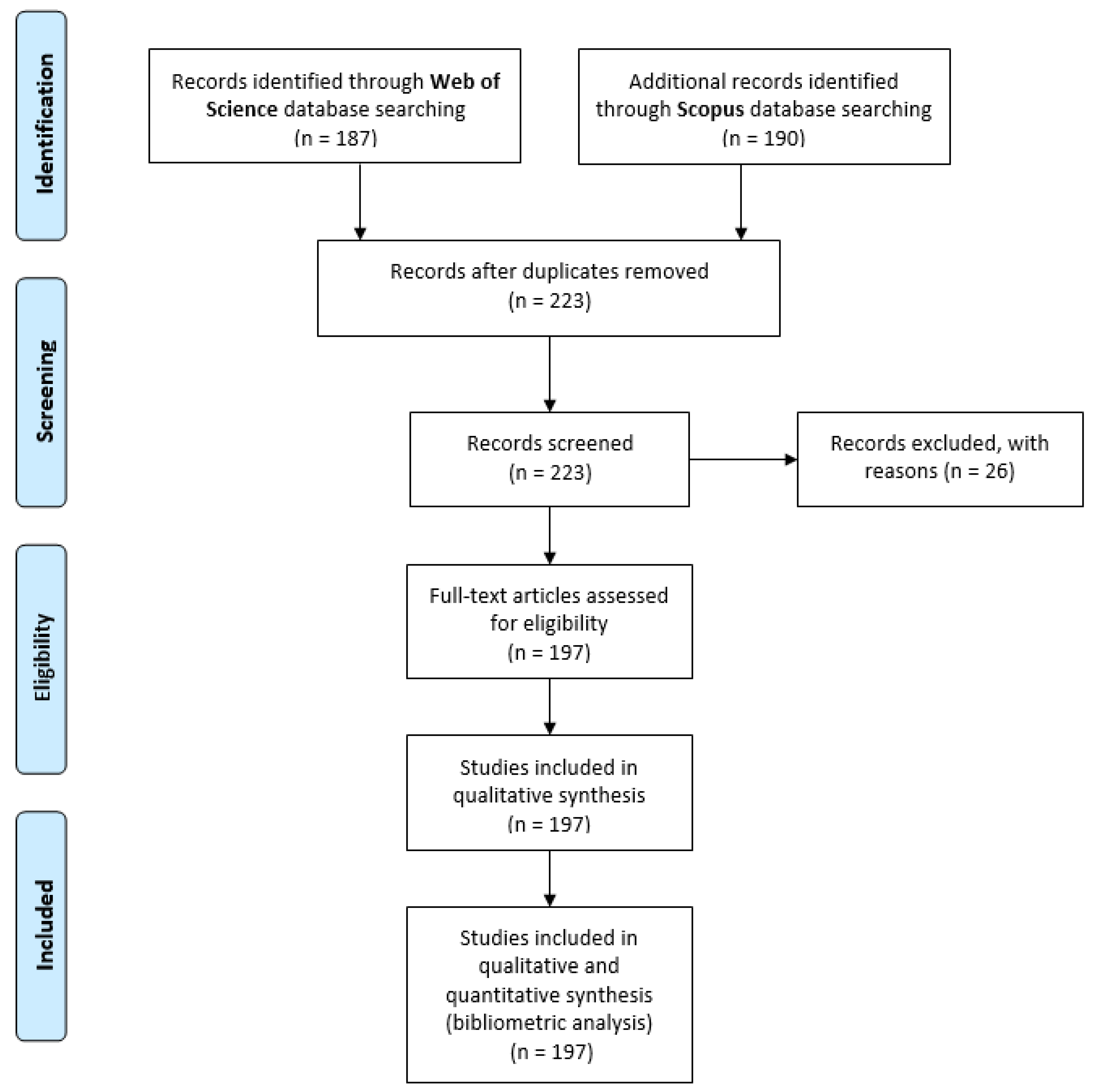
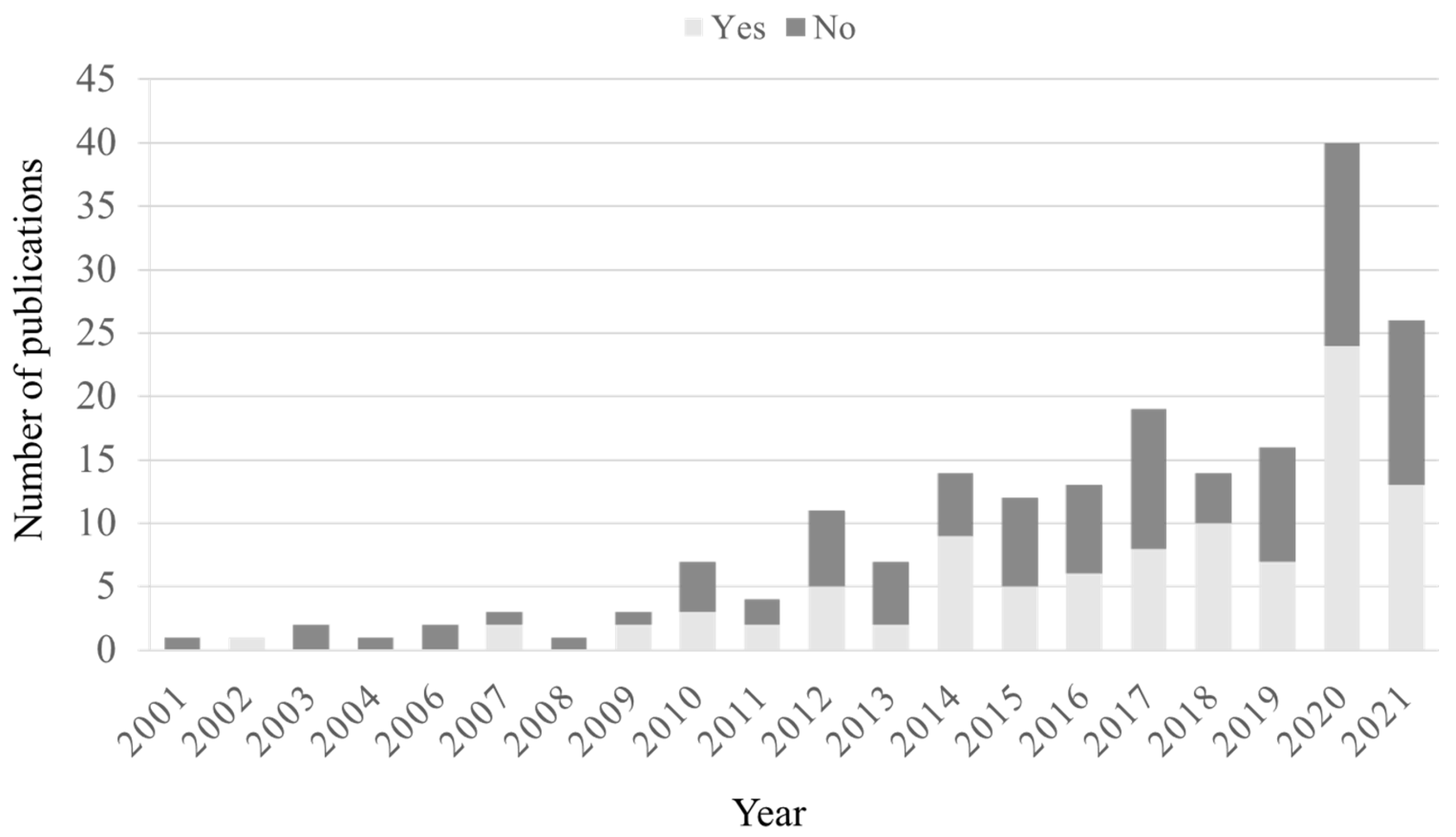
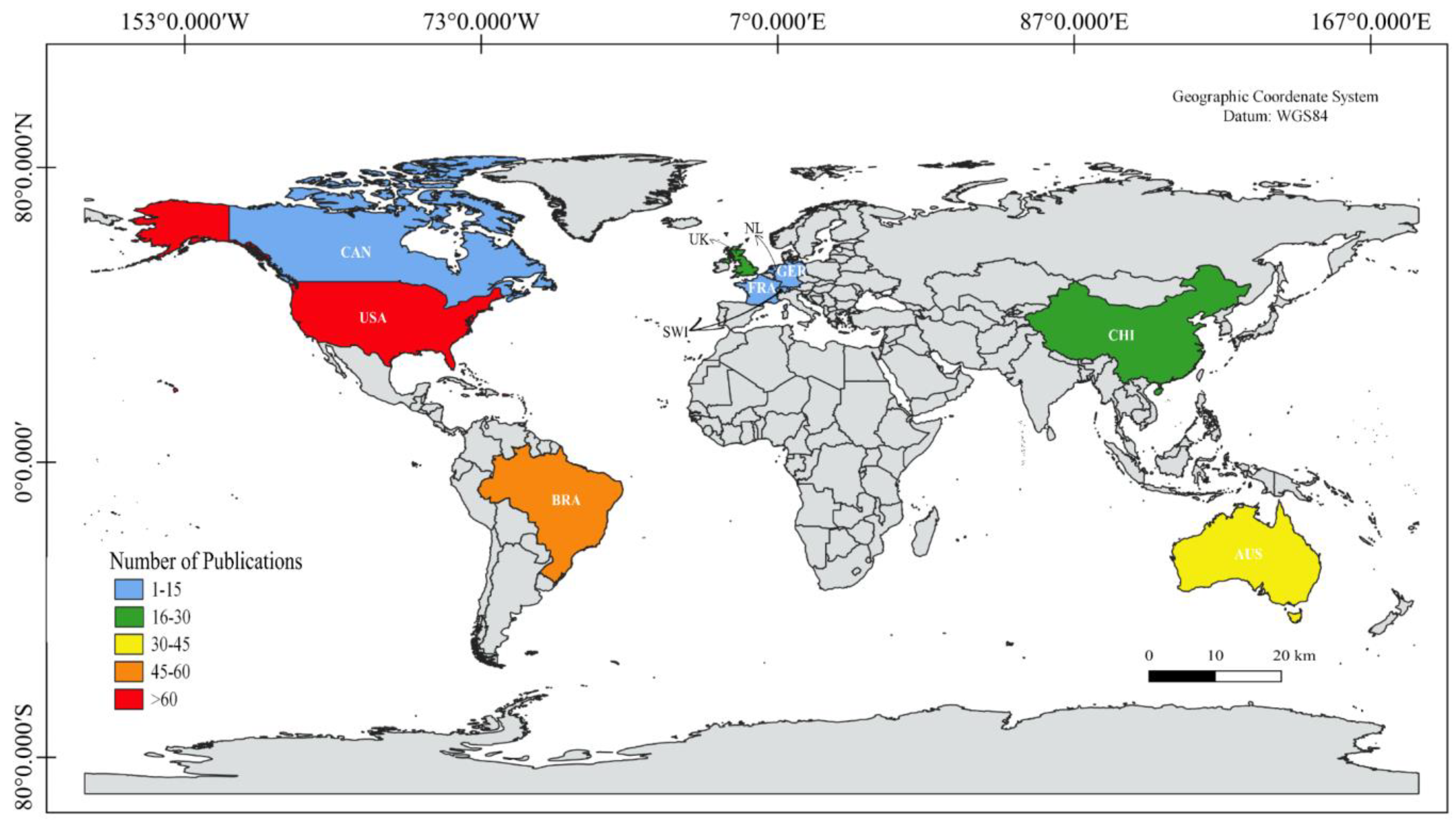
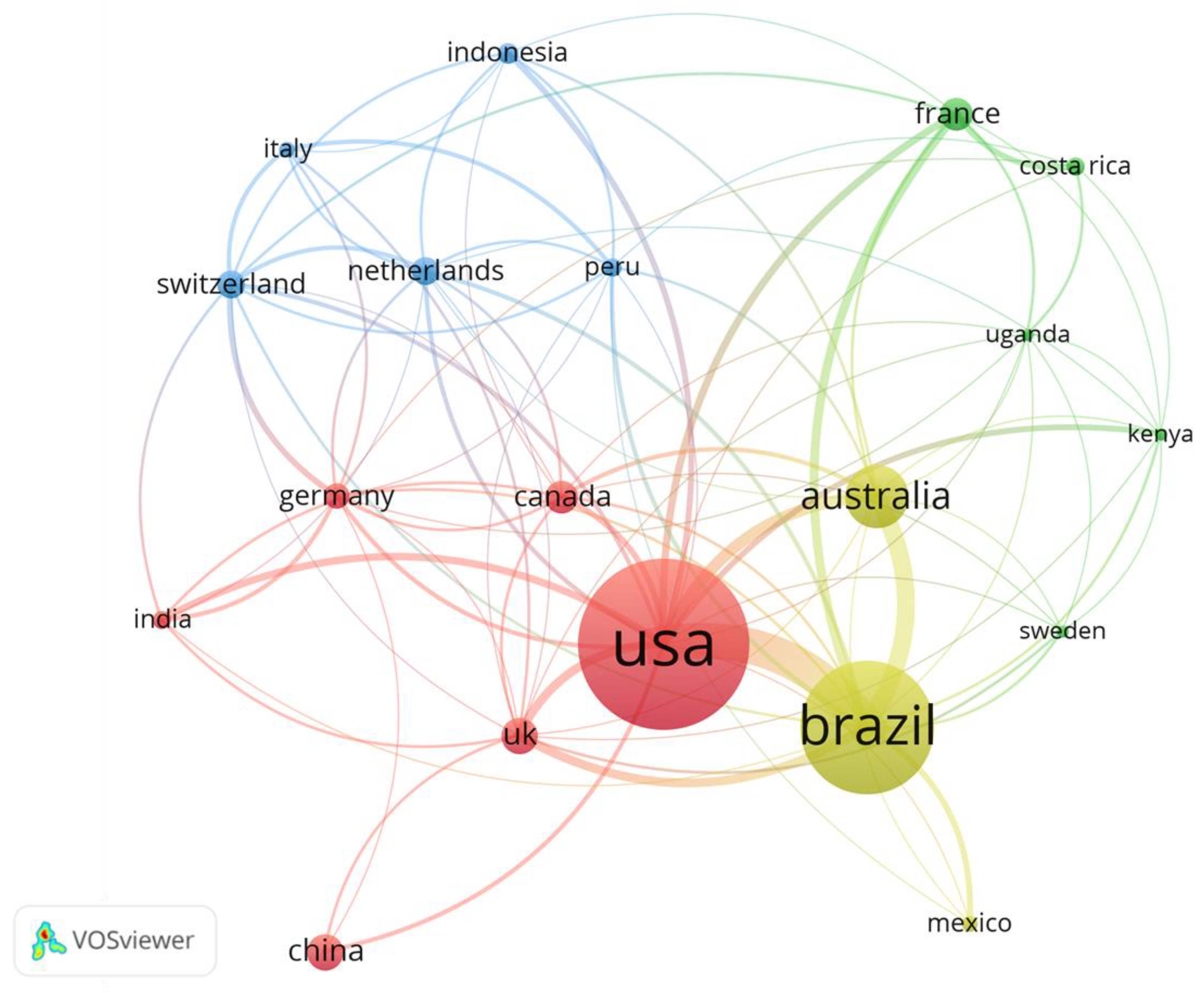
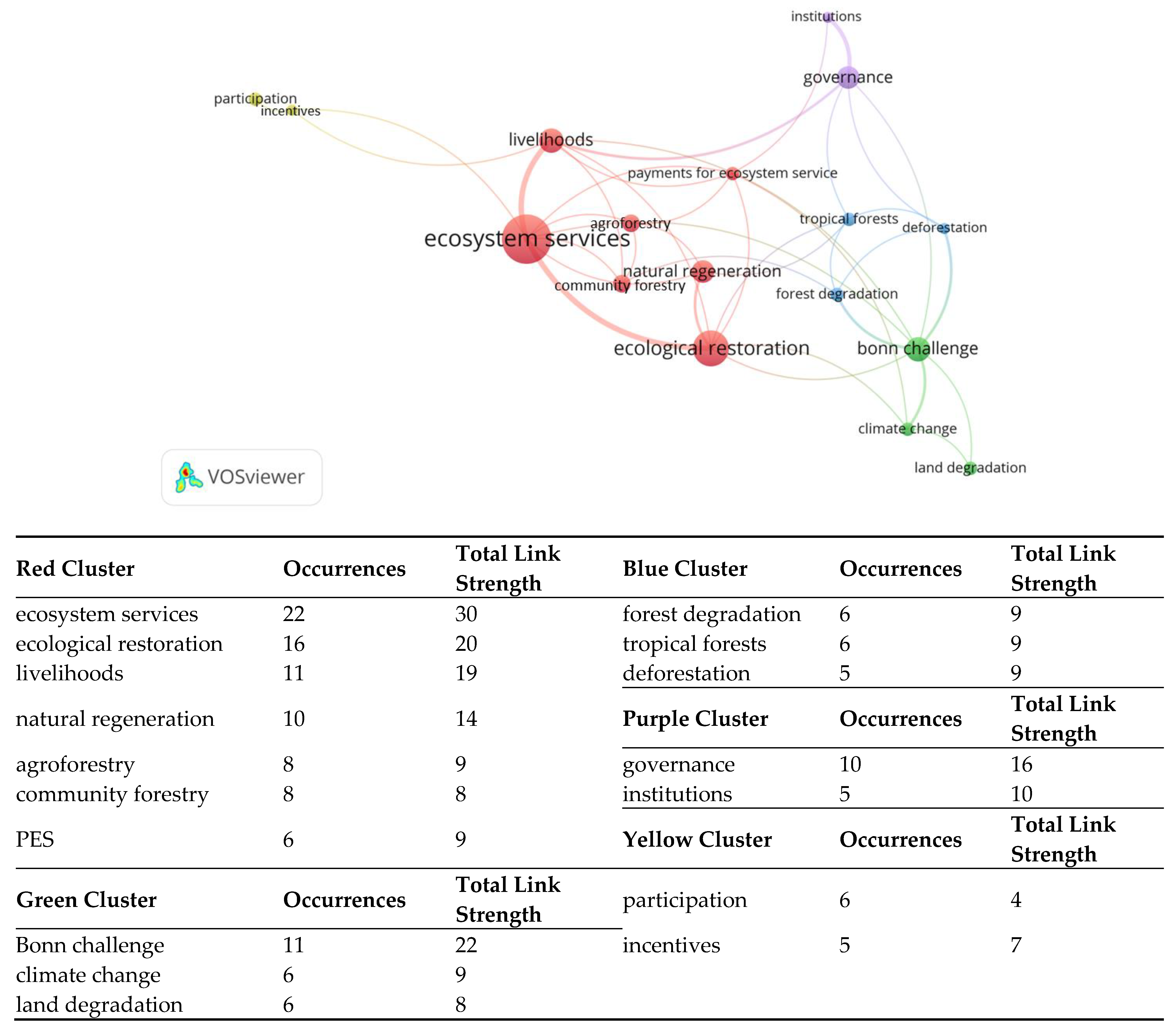
| Authors | Title | Year | Journal | Rank: Cited by WoS | Rank: Cited by Scopus |
|---|---|---|---|---|---|
| Chazdon, R.L., et al. | A Policy-Driven Knowledge Agenda for Global Forest and Landscape Restoration | 2015 | Conservation Letters | 151 (1°) | 176 (1°) |
| Le, H.D., et al. | More than just trees: Assessing reforestation success in tropical developing countries | 2012 | Journal of Rural Studies | 98 (2°) | 108 (2°) |
| Vieira, D.L.M., et al. | Agro-Successional Restoration as a Strategy to Facilitate Tropical Forest Recovery | 2009 | Restoration Ecology | 85 (3°) | 94 (5°) |
| Zahawi, R.A., et al. | Hidden Costs of Passive Restoration | 2014 | Restoration Ecology | 83 (4°) | 81 (7°) |
| Yi, Z.F., et al. | Developing indicators of economic value and biodiversity loss for rubber plantations in Xishuangbanna, southwest China: A case study from Menglun township | 2014 | Ecological Indicators | 83 (5°) | 94 (4°) |
| Melo, F.P., et al. | Priority setting for scaling-up tropical forest restoration projects: Early lessons from the Atlantic Forest Restoration Pact | 2013 | Environmental Science & Policy | 80 (6°) | 85 (6°) |
| Le, Q.B., et al. | Land Use Dynamic Simulator (LUDAS): A multi-agent system model for simulating spatio-temporal dynamics of coupled human-landscape system 2. Scenario-based application for impact assessment of land-use policies | 2010 | Ecological Informatics | 76 (7°) | 95 (3°) |
| Azevedo, A.A., et al. | Limits of Brazil’s Forest Code as a means to end illegal deforestation | 2017 | Proceedings of the National Academy of Sciences of the United States of America | 73 (8°) | 75 (8°) |
| Chazdon, R.L. and Uriarte, M. | Natural regeneration in the context of large-scale forest and landscape restoration in the tropics | 2016 | Biotropica | 68 (9°) | 67 (9°) |
| He, J. and Sikor, T. | Notions of justice in payments for ecosystem services: Insights from China’s Sloping Land Conversion Program in Yunnan Province | 2015 | Land Use Policy | 68 (10°) | - |
| Lespez, L. | Geomorphic responses to long-term land use changes in Eastern Macedonia (Greece) | 2003 | Catena | 66 (11°) | 71 (10°) |
| Richards, R.C., et al. | Governing a pioneer program on payment for watershed services: Stakeholder involvement, legal frameworks and early lessons from the Atlantic Forest of Brazil | 2015 | Ecosystem Services | 54 (12°) | 57 (12°) |
| Brancalion, P.H.S. and Chazdon, R.L. | Beyond hectares: four principles to guide reforestation in the context of tropical forest and landscape restoration | 2017 | Restoration Ecology | 49 (13°) | 53 (14°) |
| Leopold, A.C., et al. | Attempting restoration of wet tropical forests in Costa Rica | 2001 | Forest Ecology and Management | 49 (14°) | 52 (15°) |
| Orsi, F. and Geneletti, D. | Identifying priority areas for Forest Landscape Restoration in Chiapas (Mexico): An operational approach combining ecological and socioeconomic criteria | 2010 | Landscape and Urban Planning | 45 (15°) | 56 (13°) |
| Satake, A. and Rudel, T.K. | Modeling the forest transition: Forest scarcity and ecosystem service hypotheses | 2007 | Ecological Applications | 45 (16°) | 47 (17°) |
| Huang, L., et al. | Forest restoration to achieve both ecological and economic progress, Poyang Lake basin, China | 2012 | Ecological Engineering | 44 (17°) | 51 (16°) |
| Gardiner, E.S., et al. | An efforestation system for restoring bottomland hardwood forests: Biomass accumulation of nuttall oak seedlings interplanted beneath eastern cottonwood | 2004 | Restoration Ecology | 44 (18°) | 47 (18°) |
| Adams, C., et al. | Impacts of large-scale forest restoration on socioeconomic status and local livelihoods: what we know and do not know | 2016 | Biotropica | 42 (19°) | - |
| Ricketts, T.H. and Lonsdorf, E. | Mapping the margin: comparing marginal values of tropical forest remnants for pollination services | 2013 | Ecological Applications | 40 (20°) | - |
| Rank | Journals | NP |
|---|---|---|
| 1 | Forests | 16 |
| 2 | Restoration Ecology | 14 |
| 3 | Forest Ecology and Management | 11 |
| 4 | Land Use Policy | 8 |
| 5 | Biotropica | 7 |
| 6 | Land Degradation & Development | 6 |
| 7 | Sustainability | 6 |
| 8 | Journal of Rural Studies | 5 |
| 9 | Ecosystem Services | 4 |
| 10 | Journal of Environmental Management | 4 |
| 11 | Agroforestry Systems | 3 |
| 12 | Ecological Applications | 3 |
| 13 | Ecology and Society | 3 |
| 14 | International Forestry Review | 3 |
| 15 | Journal of Applied Ecology | 2 |
| Rank | Author | NP (WoS) | NP (Scopus) | Organisation |
|---|---|---|---|---|
| 1 | Brancalion, P.H.S. | 16 | 15 | University of São Paulo, Brazil |
| 2 | Chazdon, R.L. | 14 | 11 | University Sunshine Coast, Australia |
| 3 | Herbohn, J. | 11 | 11 | University Sunshine Coast, Australia |
| 4 | Gregorio, N. | 8 | 8 | University Sunshine Coast, Australia |
| 5 | Holl, K.D. | 6 | 6 | University of California Santa Cruz, United States |
| 6 | Mansourian, S. | 5 | 3 | University of Geneva, Switzerland |
| 7 | Aronson, J. | 4 | 3 | Missouri Botanical Garden, United States |
| 8 | Guariguata, M.R. | 4 | 2 | Center for International Forestry Research CIFOR, Peru |
| 9 | He, J. | 4 | 1 | Yunnan Agricultural University, China |
| 10 | Rodrigues, R.R. | 4 | 3 | University of São Paulo, Brazil |
| 11 | Stanturf, J.A. | 4 | 4 | Estonian University Life Science, Estonia |
| 12 | Viani, R.A.G. | 4 | 3 | University Federal of São Carlos, Brazil |
| 13 | Baynes, J. | 3 | 3 | University Sunshine Coast, Australia |
| 14 | Calle, A. | 3 | 3 | University of California Santa Cruz, United States |
| 15 | Fantini, A.C. | 3 | 3 | University Federal of Santa Catarina, Brazil |
| 16 | Gutierrez, V. | 3 | 3 | WeForest Asbl, Belgium |
| 17 | Harrison, S. | 3 | 3 | University of Queensland, Australia |
| 18 | Kettle, C.J. | 3 | 3 | Swiss Federal Institute Technology, Switzerland |
| 19 | Kumar, C. | 3 | 4 | International Union for Conservation of Nature, United States |
| 20 | Meli, P. | 3 | 3 | University of São Paulo, Brazil |
Publisher’s Note: MDPI stays neutral with regard to jurisdictional claims in published maps and institutional affiliations. |
© 2022 by the authors. Licensee MDPI, Basel, Switzerland. This article is an open access article distributed under the terms and conditions of the Creative Commons Attribution (CC BY) license (https://creativecommons.org/licenses/by/4.0/).
Share and Cite
Fernandes, A.A.; Adams, C.; de Araujo, L.G.; Romanelli, J.P.; Santos, J.P.B.; Rodrigues, R.R. Forest Landscape Restoration and Local Stakeholders: A Global Bibliometric Mapping Analysis. Sustainability 2022, 14, 16165. https://doi.org/10.3390/su142316165
Fernandes AA, Adams C, de Araujo LG, Romanelli JP, Santos JPB, Rodrigues RR. Forest Landscape Restoration and Local Stakeholders: A Global Bibliometric Mapping Analysis. Sustainability. 2022; 14(23):16165. https://doi.org/10.3390/su142316165
Chicago/Turabian StyleFernandes, Amanda Augusta, Cristina Adams, Luciana Gomes de Araujo, João Paulo Romanelli, João Paulo Bispo Santos, and Ricardo Ribeiro Rodrigues. 2022. "Forest Landscape Restoration and Local Stakeholders: A Global Bibliometric Mapping Analysis" Sustainability 14, no. 23: 16165. https://doi.org/10.3390/su142316165
APA StyleFernandes, A. A., Adams, C., de Araujo, L. G., Romanelli, J. P., Santos, J. P. B., & Rodrigues, R. R. (2022). Forest Landscape Restoration and Local Stakeholders: A Global Bibliometric Mapping Analysis. Sustainability, 14(23), 16165. https://doi.org/10.3390/su142316165







